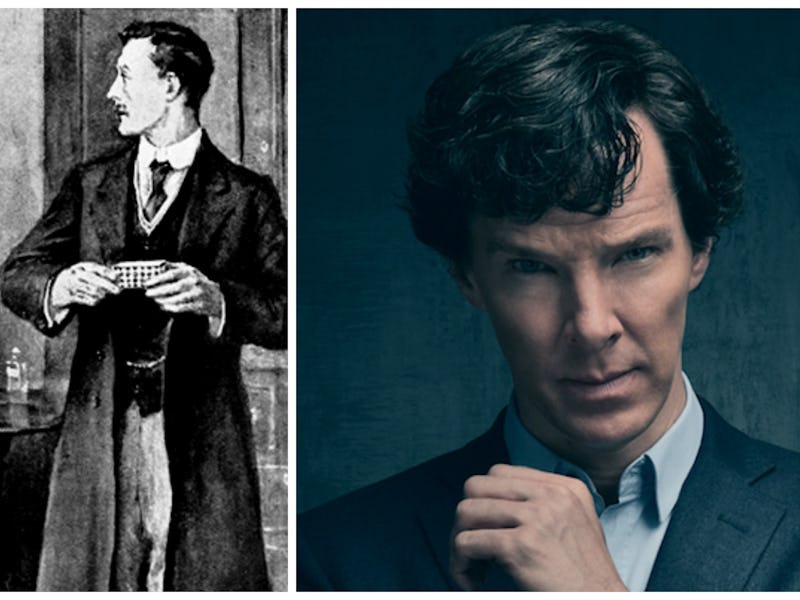Watch for These 4 Classic Book References in 'Sherlock' Season 4
The episode title-game is afoot!

With Sherlock Season 4 returning on January 1, 2017, there already might be few clues as to what will happen based solely on the existing Sir Arthur Conan Doyle canon of stories and novels.
Sherlock has never adapted any of the original stories outright, but has paid faithful tribute to the spirit of the adventures. Since it debuted in 2010, its episode titles have often given an advance clue as to what might be afoot in each adventure. With only a few exceptions, most episodes titles are a play on one of Sir Arthur Conan Doyle’s original Sherlock Holmes tales. The first episode of the show ever was “A Study in Pink” which modified the first Holmes novel, A Study in Scarlet. The second season episode “A Scandal in Belgravia” was a play on the story “A Scandal in Bohemia.” The next episode, “The Hounds of Baskerville” modifies the novel title The Hound of the Baskervilles and so on.
So, with that in mind, here are four tales from the classic Doyle canon to brush up on before season four premieres.
“The Six Napoleons”
The first episode in the new series is called “The Six Thatchers,” an obvious reference to Doyle short story “The Six Napoleons.” The original story is all about a bizarre string of vandalism in which busts of Napoleon are being smashed with a hammer. Far from being the work of someone with a political grudge against Napoleon, Sherlock Holmes deduces it’s all about what is being concealed in the busts, not what they represent. While this doesn’t tell us much about the plot itself, the original story is one in which Holmes works closely with Lestrade, which bodes well for TV’s fan favorite detective. Holmes also gives information to the press in the story which is intentionally false, something Cumberbatch Sherlock would totally do, too. There’s also a funny reference here to a character named Harker, which might have been a shout-out Conan Doyle was giving to Jack Harker from Dracula. Either way, maybe expect a vampire joke?
“The Dying Detective”
LEFT: Toby Jones as Culverton Smith. RIGHT: Smith is arrested in the original story. (Illustration by Sidney Paget)
The second episode of the new season of Sherlock is called “The Lying Detective,” a play on a fairly short, but undeniably memorable, original story titled “The Dying Detective.” In the original tale, Sherlock Holmes pretends to be on his deathbed in order to trick a criminal into admitting to the crime of poisoning. The villain of this story is named Culverton Smith, and actor Toby Jones is playing a character with the exact same name in the new season. In the story, Culverton Smith is a one-off baddie, but it is implied Holmes has been pursuing him for awhile. Some fans also have speculated for years that Culverton Smith himself and the “Giant Rat of Sumatra” (a case only referenced in the canon) are one and the same. The new Culverton Smith could be an agent of Moriarty for sure, or perhaps, different from his book persona altogether.
“The Final Problem”
The last episode of the new season is strangely entitled “The Final Problem,” which is the title of the the last story in The Memoirs of Sherlock Holmes and was — at the time of its publication — Conan Doyle’s feeble attempt to kill off the character permanently. Theoretically, the show Sherlock has already loosely adapted “The Final Problem” no less than three times before now. In the first season’s “The Great Game,” Holmes and Moriarty meet near a swimming pool, similar in tone to the Reichenbach waterfalls of the original story. But, then, Season 2’s finale “The Reichenbach Fall” more firmly established itself as “The Final Problem,” complete with Sherlock Holmes falling to, and faking, his death just as he did in the original story. Finally, last year’s one-off special “The Abominable Bride” depicted a dreamlike version of a Victorian “Final Problem,” though all of that was in Sherlock’s mind.
What could it mean this time? The best guess is that the episode could re-explore the events of “The Reichenbach Fall” and finally give us a satisfactory answer to how Sherlock really faked his death in Season 2. And if he didn’t fake his death, then who the hell is this person?
The Valley of Fear
One of the least-talked about Sherlock Holmes adventures, this novel nonetheless contains the only other direct effects of Professor Moriarty’s actions other than “The Final Problem,” and “The Empty House.” In it, Sherlock Holmes is contacted by an agent of Moriarty, and tasked with a cipher to determine the contents of the message. Starting with the agent Porlock’s riddles, the story has some of Conan Doyle’s more thrilling plot structure. Plus, it establishes that Moriarty has written a book called The Dynamics of an Asteroid. If the riddle of how Moriarty is sending messages from the dead is ever going to be answered, there may be some clues in The Valley of Fear. The only tricky thing here is that original novel contradicts the rest of the established Sherlock Holmes cannon insofar as it contains advanced information Watson has about Moriarty, that he simply shouldn’t know. Unless of course, The Valley of Fear and perhaps, this new version of “The Final Problem,” give us new insight into how and why Watson might drastically alter his chronicling of the Sherlock Holmes adventures.
Sherlock Season 4 debuts on New Year’s Day on PBS Masterpiece Mystery and BBC1.